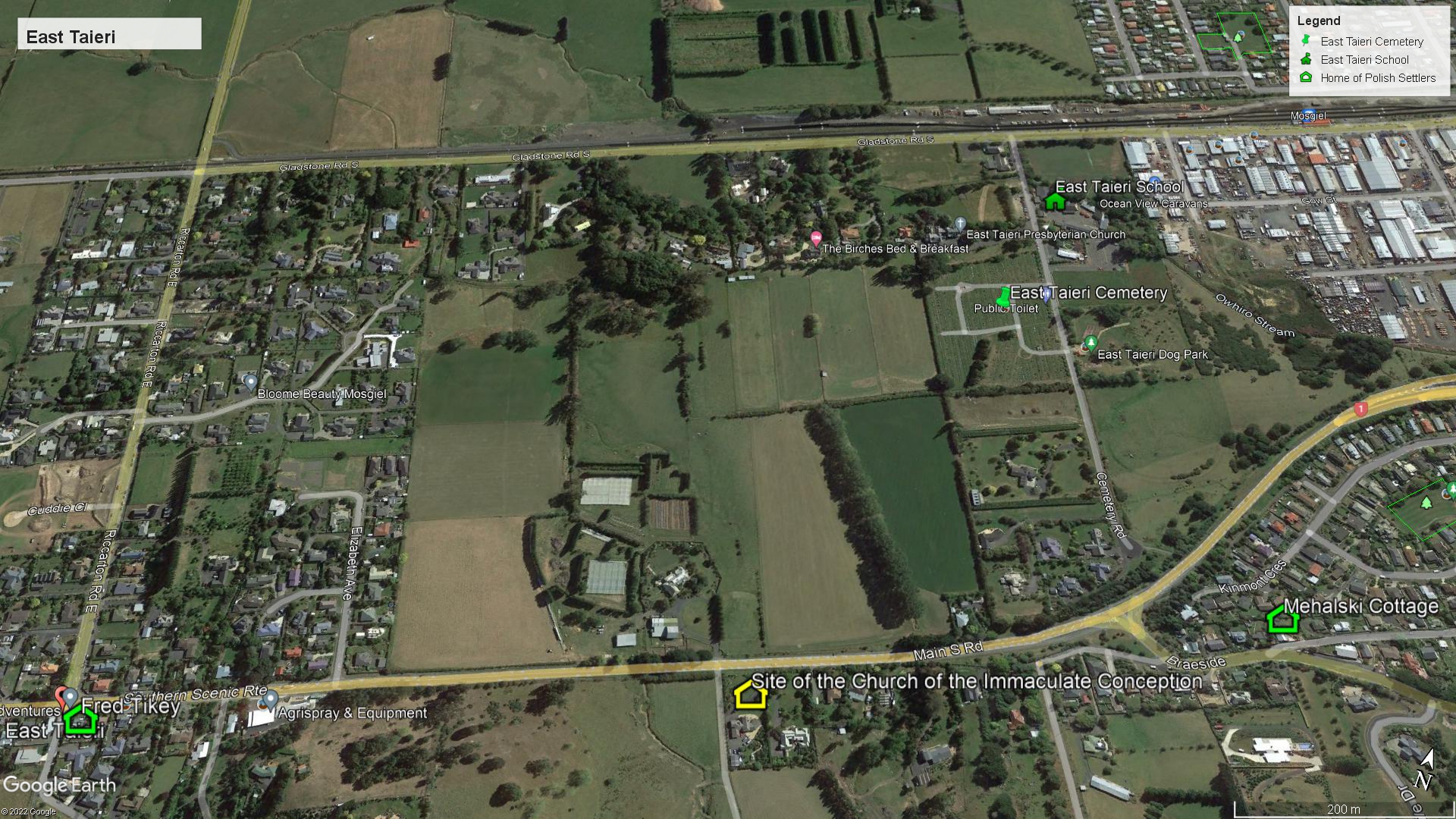Polish Settlers at East Taieri
We shall begin the history of East Taieri in the year 1848, when John de la Condamine Carnegie who had come out in the “Philip Laing” secured a 52-acre section in East Taieri which was later to become the “Grange” homestead block. The land had been recommended to him because it had “splendid soil and other natural advantages, and a finer grazing ground is nowhere to be found”. He soon sold out to Neil J. B. McGregor for 90 pounds in cash, and a gold watch valued at 30 pounds. The East Taieri School was opened on the 19th of November 1853 for the all-essential purpose of the education of the children in the district. In 1857, by public request, a cemetery was designated to the area.
By 1861, just a few months before the gold rush and its disrupting influences, the district was becoming more community conscious. The first decade of pioneering drudgery had passed and, in common with all the settlements in Otago, a dormant social sense was awakening. By this time all land, lying between “Granton” farm in East Taieri (Quarry Hill) and the soggy bank of the Silverstream in the west, had been taken up. And all the land extending along the Silverstream to the Taieri River and back along the Main South Road had also been taken up and was in course of cultivation.
The settlers in this area came from all walks of life and as a whole, the Taieri consisted of small holdings each making relentless demands of exhausting labour and time upon its owner. Wherever possible, sod cottages were being replaced by gabled wooden houses with attic bedrooms, and roads were improving very slowly as the buggy was making its appearance.
There was no definite business centre in East Taieri in 1861. The most closely settled area was about “Bellfield” and “Lauriston” and here Mrs. Betsy Oliver, a widow, opened a small store to serve her neighbours. In 1862 she also took control of the first district postal service which was a triumph for women at that time. Another store and butchery were opened about the same time by James Todd on his property “Ferniehill” on the main road above the Presbyterian church and school building.
The social centre was definitely the church and school building situated at the foot of the rise upon which the present East Taieri Church stands today. In October 1860, the newly-formed Taieri Agricultural Society which included Green Island, Saddle Hill, Kuri Bush, Moeraki Bush (Otokia), East, West and North Taieri, held its first ploughing match, taking place at “Mossgiel” farm.
The summer of 1861 saw East Taieri developing interests which was bound to extend as road and transport improved. To date this was the most populated district and it was considered safe to assume that the chief town on the plain would form here. So confident of this was John Allan, junior, of “Bellfield” that he surveyed several town sections on his property and named the embryo township Riccarton after a village in Ayrshire. However, the momentous events later in 1861 upset all town planning schemes. Riccarton was left to straggle along the main highway as necessity dictated and, in point of fact, Mosgiel Junction was the first compact business centre in East Taieri.
First came the discovery of gold at Gabriel’s Gully and not a man left on the Taieri, both fathers and sons. In consequence of the hasty exodus of local men, many of the farms suffered badly.
After the gold rush however, things were slowly progressing for the little township of Riccarton. In 1864 John Allan of “Bellfield” took over Somerville’s store and built a new one near by. The farrier work had greatly increased and was divided between R. Cramond and J. Fowler, formerly of “Mossgiel” farm, and the East Taieri Hotel (J. Souness) was built between Fowler’s forge and the store. A carpenter, W. Cooper, and a bootmaker, G. Corrans, also settled in the neighbourhood and by this time East Taieri had its own resident doctor, Dr. Inglis, who settled on the lowlands, midway between Riccarton and a new settlement, Mosgiel, which was growing up near the Big Bush.
In 1869, the present Presbyterian Church in East Taieri was built, the old wooden building being moved to Riccarton where it served as the social centre. In February, 1871, the first Roman Catholic Church on the Taieri was erected on the upper side of the main Road, opposite the “Grange” gates. The site of about 2 acres (Part of Section 35, Irregular Block, East Taieri), was donated by J. J. B. McGregor to Bishop Moran for this purpose. There were about three reasons which gave rise to the church building, being; Neill McGregor had been a trustee for the church in Dunedin, advancing money for the church at Milton, was a member of the building committee to erect the East Taieri Presbyterian church and school house and for a time it seemed that the predicted town of Riccarton would eventuate to be the chief centre of the Plains

Location of Polish Settlers and site of the Church of the Immaculate Conception at East Taieri & Mosgiel Junction, courtesy of Google Earth
When the first Bishop, Dr. Moran arrived in Dunedin in 1871, to establish a diocese in Otago, he opened the first Catholic church on the Taieri Plain, and consecrated it the “Church of the Immaculate Conception”. This was the only Catholic Church in the area between Dunedin and Milton. Two years later the parish of Milton was formed. It was then a large area extending from Green Island to the Catlins River. The first Parish Priests to minister the parish were Father Coleman of Dunedin and Father Lenihan of Milton, whose eleven years of strenuous service took such a toll of his health that he was forced to retire temporarily from active services in 1884.
“The erection of a Roman Catholic church and school at East Taieri is in contemplation. The proposed site is at the Grange, and 50 pounds, according to a Tokomairiro paper, has already been raised in the Otakia district in aid of the building fund.“ Otago Daily Times”, 17th June 1870.
“The right Rev Dr. Moran, Bishop of Dunedin, will on next Sunday consecrate the newly erected Catholic church in East Taieri (or Grange) at 11 o’clock on Mr. McGregor’s farm, East Taieri”.
“A four-horse coach will leave the Gridiron Hotel, tomorrow morning at 9 o’clock sharp, for the purpose of conveying parties desirous of witnessing the above interesting ceremony, returning immediately after. Fares moderate. (Public Notices).“ Otago Daily Times, 25 February 1871
Infrequent as the religious ceremonies were in the church at this time due to the fewness of priests, the chapel building on the rise looking over the Taieri Plains was to the Catholics of the district a silent witness to them of God’s presence in their joys and sorrows. The McGregor family had since leased this farm and had moved from the “Grange” to “Ellensdale”, named after their youngest daughter. McGregor’s home had been a veritable “haven of rest” to travelling priests on the early missions. But whenever Sunday Mass was to be celebrated in the little chapel at East Taieri the Catholics would gather from all over the Taieri with a sense of pride, faith and joy.
This was particularly so of the many Polish families who seeking freedom for themselves and their children took advantage of Sir Julius Vogel’s program to bring in immigrant labour to develop Public Works, arriving in the area early 1873. Records show that Bishop Moran officiated in January 1875 the marriage of Joseph Pedofski and Maria Velinski. Another Polish couple who married here were between Johann Switalla and Martha Piernicka on the 10th of November 1881, both of Allanton (Greytown).
The small farming community of Wingatui situated at North Taieri enjoyed uninterrupted peace until 1875, when crude noises of modern progress shattered the pastoral calm and reverberated about the hills. Gangs of workmen, many of them speaking a foreign language, swarmed about the vicinity of “Spring Garden” and, on May the 31st, 1875, chronological records announce that the Chain Hills tunnel was pierced. The railway had reached the Taieri and continued its inevitable course southwards.
One Polish family who resided in Riccarton was the Michalski family. They arrived on the ship “Palmerston” in December of 1872. Here Johann Michalski was employed on heavy labour-intensive work, clearing and preparing the area ahead for the proposed railway line though East Taieri. They later moved to Mosgiel Junction in 1904.
Another family from Poland with the name of Tikey (Tieke) also arrived on the Palmerston. They took up residence in Riccarton between the years 1884—1888 after working on the main trunk line. Frederick Tikey also worked as a labourer and coal miner in the district.
Coal had been mined on the southern face of Saddle Hill for nearly thirty years before it was discovered on the Christies’s property, and the Christies themselves had been some years at “Luther Bank” before the chance sinking of a well revealed the hidden treasure beneath their home paddocks. The mine started working in 1875, and thereafter for forty-five years, coal-carts travelled up and down the long hill road between the coal-pits and the plain.
Bishop Moran could see that the little church at East Taieri was inadequate to cater for the growing population of Mosgiel and also that it was not conveniently situated for the great number of Catholics now living in Mosgiel.
Sixteen years later the foundation stone of St Mary’s Church in Gordon Road, Mosgiel, was laid by Bishop Moran on the 19th of June 1887. It is believed on the 24th of June 1887, the church at Riccarton (East Taieri) was taken down and re-erected at Greytown for the accommodation of Polish Catholics who resided there. It was Father James O’Neill (1884-1904), of the Milton Parish, who supervised the dismantling and rebuilding at the new site.
At Riccarton, fire removed the East Taieri Hotel and athenaeum, two old landmarks which were never replaced, and, with the coming of the twentieth century with its motor transport and tar-sealed roads, much that was picturesque was forfeited in the interests of progress.
In 1886 William Ings of St. Clair bought part of R. Crammond’s property in East Taieri and had it drained and prepared for fruit-growing and were considerably enlarged during the following four or five years.
Dunedin citizens also recognised the district as a quiet place to retire, and pretty houses and gardens appeared on the lower slopes of the eastern hills. They face the sun and overlook a wide vista of plain—richly productive but, as yet, comparatively treeless. The earliest settlers of regrettable necessity, cut down the remnants of an ancient and beautiful forest which once grew thick about the plain.
In 1890 a property in Chaucer Street, Mosgiel, was bought for a convent. The cottage contained four small rooms and two attics, and for several years served as a residence for the five Dominican sisters who came on January the 9th, 1891. Mother Gabriel (Prioress of St. Dominics, Dunedin), Sister M. Albertus (Hall), Sister M. Aquinas (Gwane), Sister M. Hyacinth (O’Neill) and Sister M. Anne (Walsh). They came a week earlier than expected, and were delighted to be given an unscheduled drive to the beach in a trap, while preparations for their coming were completed. On their return, Mrs. Lynch welcomed them to their new convent. The following Sunday, January 11th, was solemnly blessed by Bishop Moran.
The school roll at that time had the names of about 120 pupils, some of whom were children of Polish parents living at Waihola, some from Allanton, Henley and Otokia, while some came by train from as far south as Balclutha.
A Kindergarten was later established, Father Scanlan being one of the first pupils.
On Pentecost Tuesday, May the 19th, 1891, the foundation stone of the new brick church-school on the ground adjoining the convent, was laid by Bishop Moran, who also opened for worship the completed church on January the 24th, 1892. One month later on the 9th of February, Bishop Moran opened the parish school.
Miss Katherine McLachlan was the first teacher and in 1895 her sister Alice came to assist her. These two Milton women continued in the school until May 1898.
At the request of the Bishop, the Sisters of Mercy took charge of the School in 1898 and for the first few months two sisters travelled daily from Dunedin to Mosgiel to teach. This travel proved to be very inconvenient and it was found necessary to establish a convent in Mosgiel. A cottage in Gordon Road was rented for the Sisters and this marked the beginning of a long association between the Sisters and the School. In 1898 there were 36 pupils on the roll. School continued to be taught in the Church until 1912.
In 1912 Father Liston (later to become Bishop of Auckland) purchased a brick building belonging to the Taieri Drainage Board on the corner of Wickliffe and Church Streets, admirably suited for use as the school. The roll at that date was fifty pupils.
The heating of the school was a very difficult task. As the building was also used for the church no chimney was built. An aisle in the parish church was walled off for use as a school room. Later almost the whole of the church had to be used for school purposes. The first winter, a large iron pan containing lighted charcoal was moved from place to place, but it was an ineffective method of heating.
Early in 1896, school was commenced in the old church, which Mr. Hassett had moved intact from High Street to a block adjoining the convent, in accordance with the wishes of Sister M. Hyacinth, who had been given the land as a present by Mr. Scanlan.
The Stations of the Cross, still in the church are the ones painted in Ireland, and erected to the memory of Sister M. Hyacinth by her brother Father O’Neill.
Of even greater importance in the life of the church was the establishment of the major seminary of Holy Cross College. In 1899 the Provincial Council of New Zealand met in Wellington and decided to establish a seminary in the diocese of Dunedin. Bishop Verdon arranged the purchase of eleven acres on which stood the original “Mossgiel” homestead erected by Mr. Arthur Burns. On May the 3rd, 1900, the college was opened and solemnly blessed by Bishop Verdon, assisted by Bishop Grimes.
One of the early residences of the college was that of Martin Joseph Klimeck, born in Waihola of Polish parents who arrived to build the railways. Father Esmond Klimeck, O.P., was ordained into the Priesthood on the 9th of December, 1920. He is claimed to be the first priest in New Zealand of Polish descent.
As the years passed development became static round East Taieri and the Woolen Mills in the Mosgiel township began to build up the population in that area. Shops and dwellings increased in numbers. Owing to the enterprise of A. J. Burns, son of the Rev. Thomas Burns, Mosgiel was destined to become the chief centre of the Plain. Riccarton or East Taieri as it is better known today is now a quaint settlement of a few houses and one shop lying in the shadow of Saddle Hill.
Funerals at St. Mary’s in Mosgiel.
“DEATHS. MEHALSKL—-On May 16, 1933, at her daughter’s residence (Mrs G. Restieaux), Clyde street, Mosgiel Junction, Johanna Agnes, beloved wife of the late John Mehalski; aged 94 years. R.I.P. —Requiem mass St. Mary’s Catholic Church, Mosgiel, on Thursday, the 18th inst., at 9 a.m. —Private interment. Hugh Gourley, Ltd., undertakers.” Otago Daily Times, 17 May 1933, p 6
“DEATHS. KOVALESKI. —On July 8, 1941, at his residence, 8 Ayr street, Mosgiel, Francis Anthony, dearly beloved husband of Annie Elizabeth Kovaleski, in his 81st year. R.I.P. Requiem Mass at St. Mary’s Catholic Church, Mosgiel, on Thursday, at 9 a.m. —Funeral will leave the church at 2 p.m. on Thursday, for the Allanton Cemetery, —R. Campbell and Son, funeral directors.” Evening Star, 8 July 1941, p 4
Compiled by Paul Klemick (2022)

